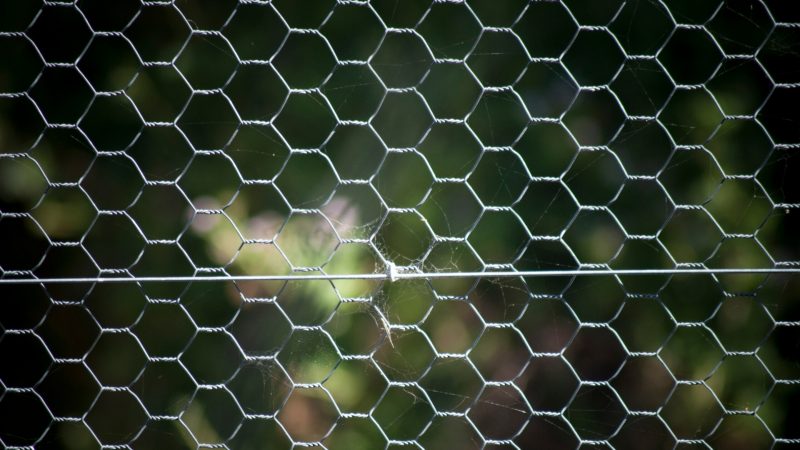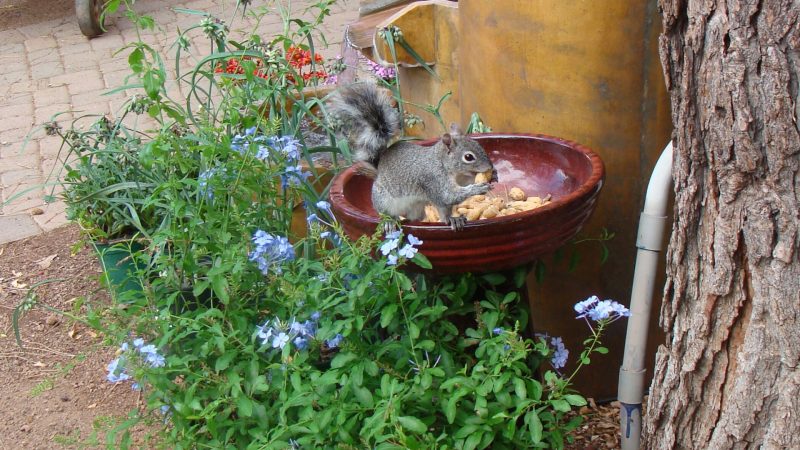Whether you’re a veteran home gardener or planting your seeds for the first time this season, one of your biggest concerns is going to be pest control. Squirrels in particular are drawn to the clusters of fresh produce each year, and it’s up to you to get creative with the ways to keep them from eating the fruits of your labor.
Does chicken wire keep squirrels out of gardens? Chicken wire is a great solution for keeping squirrels out of your garden. Choosing the right gauge (thickness), mesh size (space between the threaded wires), and the width of the chicken wire will play an important role in the effectiveness of this squirrel control method.
The rest of this article will explain the different types of chicken wire, tips for installing it, and other ways you can keep squirrels out of your garden this summer. This is certainly going to be an interesting read that will help you immensely with your squirrel problem. Let’s begin!
Chicken Wire for Squirrel Control: Important Factors
Chicken wire is a type of mesh wire typically made of galvanized steel. This fencing material is used to keep chickens and other poultry inside a specific location, and also to keep small animals (pests) out of gardens and other areas you want to protect.
There are four different factors to consider when choosing the right size chicken wire for your needs. To decide what size you need, you’ll first need to understand these characteristics – gauge, mesh size, material, and width.
Gauge
A gauge is used to describe the diameter of a wire. Wire gauges can range from 0 (8.2 mm) to 48 (0.04 mm), signifying the different thicknesses of each wire. Something important to understand about wire gauges is that the lower the number, the thicker the wire will be.
Chicken wire comes in a wide range of thicknesses, varying from 19 gauge (1 mm) to 22 gauge (0.7 mm). Because the gauge is relatively low, chicken wire is easy to manipulate, yet strong enough to prevent creatures from gnawing through it to get to your precious plants.
Mesh Size

Mesh size, when referring to the wire, is the number of openings per 1-inch linear cross-section on the wire. Chicken wire comes in various mesh sizes, ranging from 3/8 inches (10mm) to 4 inches (100mm), depending on the material it’s made of.
The most common mesh size for chicken wire and the one you are likely most accustomed to seeing is 2-inch (50mm) wire. This means that for every linear inch of the wire fabric, there are two holes. While this may be sufficient for keeping medium-sized rodents like squirrels from entering your garden, it is recommended that you stick with a smaller mesh size.
Materials
There are multiple materials used to manufacture chicken wire, but the most popular ones are galvanized steel or PVC-coated steel. These materials are great for outdoor fencing solutions because they are durable, easily manipulated, and relatively weather-proof.
The zinc coating used in galvanized steel acts as a barrier between the steel metal wire and the outside elements, protecting it from rust or corrosion. This is beneficial when considering what to use to keep pests out of your garden because the metal won’t break down over time, and won’t become easier to chew through.
PVC-coated steel is another popular material used for chicken wire. The PVC coating, made up of a synthetic plastic polymer, protects the steel underneath it from the outside elements so it also won’t rust or corrode. The coating makes it flexible and easy to manipulate around whatever area you need to protect.
Width
Chicken wire comes in a variety of widths in order to suit any need. The width of the chicken wire roll is directly dependent upon the mesh size. The shorter the mesh, the shorter the width of the wire roll. To keep pests out of gardens or other areas, the deciding factor should be the mesh size and not so much the width.
Tips for Installing Chicken Wire to Keep Squirrels Out
Now, we are going to give you some of our recommendations for the chicken wire that can be used as a perimeter fence for keeping other pests including squirrels out of your garden.
SATINIOR 2 Sheets Chicken Wire Net
- Package includes: 2 sheets chicken wire net, the size of each...
- Material: these chicken wire nets are made of galvanized wire,...
- Purpose: the small piece of chicken wire is mainly applied in...
- Mesh size: the hole of chicken wire is in suitable size of about...
- Widely apply: the chicken wire mesh is wide and long enough to...
- This are easy to use
- This are highly durable
- This is manufactured in United States
- Brand name:YARDGARD
MTB Sturdy Duty Fence Post U Post 3 Feet, Pack of 10
- Package contains 10 pcs wire fencing post, chicken wire...
- Tabs on post allow for easy anchoring of rolled fence product as...
- 14-gauge rugged steel(1.3" wide steel) and 3” x 3.5” swedged...
- The green powder coating enhances outdoor life and prevents...
- You can easily install on signs,garden fence,corner anchor posts,...
The type of chicken wire is also situational to the location that you want to protect. This means you will have to do a lot of thinking and find the one that fits your needs.
Additionally, if you are going to build a complete and stable fence you will maybe also need some resistant cable ties as they can almost always come in handy.
TR Industrial Multi-Purpose UV Resistant Black Cable Ties
- Made with UV resistant industrial strength 6/6 Nylon
- 100 8 inch pieces
- 50 lbs tensile strength
- Working temperature: -40-85 degrees C or -40-185 degrees F
- Strong cable ties usable in many applications
Mesh Size
When installing a chicken wire around a garden or other areas that you want to protect from small critters (squirrels), you’ll first want to consider the mesh size of the chicken wire roll.
It is recommended that you use a chicken wire mesh that is no bigger than 1 inch (25 mm) to keep out animals like squirrels, raccoons, or rabbits. Anything bigger than that will allow animals to slip right through the hole into your garden.
Depth
Because squirrels can dig and burrow, you will want to make sure that you bury the chicken wire far enough into the ground to prevent them from going right under it into your garden.
It is recommended that you bury at least 12 inches (30.5 cm) of the chicken wire underneath the ground, just be on the safe side.
Height
Squirrels are natural climbers, so you’re going to have a difficult time determining the appropriate height of your chicken wire fence. One alternative you can make to your fencing design is to construct a chicken wire cage, rather than a fence, complete with a roof to keep squirrels from shimmying up the perimeter of the fence and directly into your garden.
Other Ways to Keep Squirrels Out of Gardens

If a chicken wire fence is not an option for you, there are other ways you can keep squirrels out of your garden without any fencing. Here are a few things you can do:
1. Remove Potential Food Sources
Squirrels will go for low-hanging fruit or nuts, so be sure to clean up if any of them fall to the ground. Making things easy for them will attract squirrels even more.
2. Use Repellents
Squirrels tend to avoid spicy or minty aromas, so sprinkling a layer of black pepper or planting mint near the areas you’re trying to keep squirrels away from will help to keep them at a distance. They also dislike coffee grounds, so adding a layer of those around the perimeter will also work well.
3. Use Natural Repellents
Squirrels will avoid certain plants like marigolds, mustard greens, daffodils, or geraniums because of the smell and taste they omit. Planting these nearby will work to keep squirrels away, much like black pepper or mint.
4. Redirect Them
If you have a big squirrel population living in your area, and you’ve found that other alternatives just aren’t working for you, try setting up a dedicated food source away from your garden or area you’re trying to “squirrel-proof.” Squirrel feeders, like the Pennington Squirrel Snacker Feeder, are a great way to redirect squirrels. The bonus is that birds will love this feeder as well!
- This multi-functional feeder can be used for squirrels or birds
- Constructed of Eastern Red Cedar natures renewable resource
- Easy to fill and clean
- Easy to hang with hanging hardware included
- Attracts squirrels and chipmunks or birds
5. Scare Them Off
Many birds of prey, like hawks or owls, are considered predators of squirrels. Try placing a figurine of a natural squirrel predator nearby to scare them off. Be sure to periodically move the figurine around, so the squirrels do not become used to it.
- SOLAR POWERED: No batteries or power cords required; Movement...
- INCREDIBLY REALISTIC: Our patented Natural Enemy Scarecrow...
- DYNAMIC MOVEMENT: With a 360° range of motion, the Owl’s...
- NOT JUST A SCARECROW: If you are an owl lover, you will be...
- PREMIUM QUALITY: Our rotating head decoy is non-toxic and...
Related: Do Wind Chimes Scare Away Squirrels?
List of Sources
Cochran S., Preventing Conflicts With Tree Squirrels, University of Nebraska – Lincoln
Brittingham M., Tree Squirrels, College of Agricultural Sciences, The Pennsylvania State University
Squirrel Nuisance Problems, Connecticut’s Official State Website
Squirrel Control, Missouri Department of Conservation
- How to Get Rid of Copperheads | Practical Guide - August 27, 2023
- How to Get Rid of Corn Snakes | What Makes Them Aggressive? - August 27, 2023
- How to Get Rid of Alligators | Safety Measures and Removal Methods - July 16, 2023






